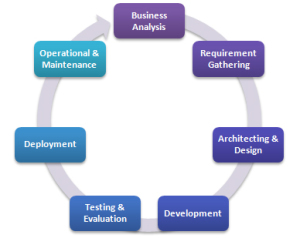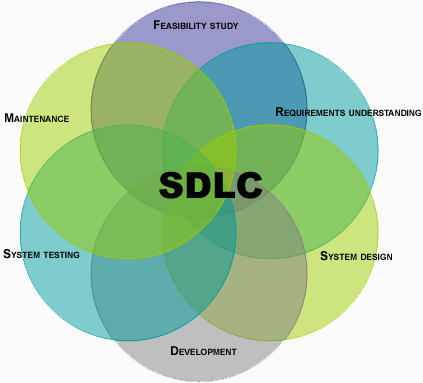 SDLC stands for Software Development Life Cycle. The systems development life cycle, additionally referred to as the application development life-cycle, it is a term utilized in systems engineering, information systems and software engineering to portray a process for planning, engendering, testing, and setting up an information system. The systems development life-cycle theory applies to a set of hardware and software framework, as a system can be composed of hardware, software, or a mixture of both.
SDLC stands for Software Development Life Cycle. The systems development life cycle, additionally referred to as the application development life-cycle, it is a term utilized in systems engineering, information systems and software engineering to portray a process for planning, engendering, testing, and setting up an information system. The systems development life-cycle theory applies to a set of hardware and software framework, as a system can be composed of hardware, software, or a mixture of both.
A Software Development Life Cycle is typically a series of phases, that afford a model for the development and lifecycle management of an application or piece of software. The methodology within the SDLC process can alter across industries and organizations, but standards such as ISO/IEC 12207 represent processes that establish a lifecycle for software, and provide a mode for the development, acquisition, and configuration of software systems.
A systems development life cycle is composed of a number of vividly defined and noticeable work phases which are utilized by systems engineers and systems developers to plan for, design, build, test, and distribute information systems. Like anything that is manufactured on an assembly line, an SDLC aims to accomplish high quality systems that accommodate or exceed customer prospects, predicated on customer requisites, by distributing systems which move through each vividly defined phase, within scheduled time-frames and cost estimates. Computer systems are intricate and often tie numerous traditional systems possibly supplied by different software vendors. To manage this caliber of intricacy, a number of SDLC models or methodologies have been generated, such as “waterfall”; “spiral”; “Supple software development”; “rapid prototyping”; “incremental”; and “synchronize and stabilize”.
There are numerous software development approaches describe and designed which are utilized during improvement practice of software, these approaches are withal referred as Software Development Process Models. Every process model follows a particular life cycle in order to ascertain prosperity in process of software development.
Software life cycle models depict phases of the software cycle and the sequence in which those phases are carried out. Each phase accomplish deliverables required by the later phase in the life cycle. Requisites are interpreted into design. Code is composed in accordance to the design which is called development phase. After coding and development the testing verifies the distributable of the implementation phase against requisites.
There are following six phases in every Software development life cycle model. They are mentioned below:
The target of a SDLC process it to aid generate a product that is cost-efficient, efficacious, and of high quality.
Requirement analysis and defining:
SDLC commences with the analysis and definition phases, where the purport of the software or system should be tenacious, the goals of what it requires to accomplish need to be established, and a set of definite requisites can be developed. Business requisites are accumulated in this phase. This phase is the prime point of convergence of the project managers and stake-holders. Convocation with managers, stake-holders and users are held in order to determine the requisites like; Who is going to utilize the system? How will they use the system? What data should be input into the system? What data should be output by the system? These are general questions that get answered during a requisites amassing phase. After requisite gathering these requisites are analyzed for their validity and the possibility of incorporating the requisites in the system to be development is additionally studied.
Design:
In this phase the system and software design is processed from the requisite designations which were studied in the first phase. System Design avails in designating hardware and system requisites and also avails in defining overall system architecture. The system design designations accommodate as input for the next phase of the model. Determinately, a Requisite Designation document is created which accommodates the purport of guideline for the next phase of the model.
Developement/Construction:
During the software construction or development stage, the genuine engineering and writing of the application is done. The software is designed and produced, while endeavoring to achieve all of the requisites that were set forth within the earlier stage. Next, in the software development life cycle is the testing phase. Code composed during construction should be tested utilizing static and dynamic analysis, as well as manual perforation testing to ascertain that the application is not facilely exploitable to hackers, which could result in a cynical security breach. On acceptance of system design documents, the work is divided in modules/units and genuine coding is commenced. Since, in this phase the code is generated so it is the primary focus for the developer. This is the prolonged phase of the software development life cycle.
Testing:
After the code is developed it is tested against the requisites to ascertain that the product is genuinely solving the desiderata addressed and accumulated during the requisites phase. Throughout this phase unit testing, integration testing, system testing, acceptance testing are done.
Deployment:
After prosperous testing the product is distributed / deployed to the customer for their utilization.
Maintenance:
Once when the customers commences utilizing the developed system then the genuine quandaries comes up and needs to be solved from time to time. This proceeding where the care is taken for the advanced product is known as maintenance.
Once the software is deemed secure enough for use, it can be implemented in a beta environment to test authentic-world usability, and then pushed a full release where it enters the maintenance phase. The maintenance stage sanctions the application to be accustomed to organizational, systemic, and utilization changes.
Importance Of SDLC Implementation:
There are two variants of SDLC that can be used: waterfall and agile. The major distinguishment between the two is that the waterfall process is more traditional and commences with a well thought out plan and defined set of requisites whereas agile SDLC commences with less stringent guidelines and then makes adjustments as needed throughout the process. Rapid development is known for its ability to expeditiously translate an application that is in development to a full release at proximately any stage, making it apposite for applications that are updated frequently.
DLC can be described along a spectrum of supple to iterative to sequential.Supple methodologies, such as XP and Scrum, fixate on lightweight processes which sanction for rapid changes along the development cycle. Iterative methodologies, such as Rational Coalesced Process and dynamic systems development method, fixate on constrained project scope and expanding or amending products by multiple iterations. Sequential or big-design-up-front models, such as waterfall, fixate on complete and rectify planning to guide astronomically immense projects and jeopardizes to prosperous and predictable results. Other models, such as anamorphic development, tend to focus on a form of development that is guided by project scope and adaptive iterations of feature development.
In project management a project can be distinguished both with a project life cycle (PLC) and an SDLC, during which remotely divergent activities occur. According to Taylor “the project life cycle encompasses all the activities of the project, while the systems development life cycle fixates on realizing the product requisites”. SDLC is used during the development of an IT project, it describes the different stages involved in the project from the drawing board, through the completion of the project.
Therefore this discussion has analyzed and scrutinized the fundamentals of software development life cycle. Being a crucial segment of the 21st century entering a global international economy where most of our routine activities as well as global communication and transactions are restrained by the Information technology systems having steady and efficient software plays a crucial role. Therefore, a remarkable understanding of the software development life cycle, its phases ascertains the software developers,and IT personnels a higher rate in eliminating failures before the final production. Which in turn enable us prosper in the centuries to come.









Leave A Comment